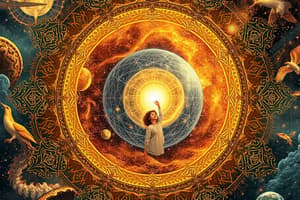Podcast
Questions and Answers
What is the initial state of the universe referred to as?
What is the initial state of the universe referred to as?
- Primordial atom (correct)
- Thermal equilibrium
- Dark matter core
- Cosmic void
Which process is responsible for the formation of the different types of nuclei?
Which process is responsible for the formation of the different types of nuclei?
- Recombination
- Cosmic inflation
- Gravitational collapse
- Nucleosynthesis (correct)
What phenomenon allows space itself to expand faster than the speed of light during the universe's early development?
What phenomenon allows space itself to expand faster than the speed of light during the universe's early development?
- Quantum entanglement
- Relativistic dilation
- Inflation (correct)
- Dark energy
What occurred after nucleosynthesis that allowed for the formation of neutral atoms?
What occurred after nucleosynthesis that allowed for the formation of neutral atoms?
What were the primary particles present in the universe after it expanded and cooled down?
What were the primary particles present in the universe after it expanded and cooled down?
Which force was responsible for the eventual collapse of atoms to form stars and galaxies?
Which force was responsible for the eventual collapse of atoms to form stars and galaxies?
Flashcards are hidden until you start studying
Study Notes
Origin of the Universe
- The universe originated from an infinitely hot and dense state known as a "Primordial atom."
- Initial singularity contained all space, time, matter, and energy, resulting in a lack of defined location, time, or form.
Inflation and Expansion
- Rapid expansion, termed inflation, occurred immediately after the singularity, with space expanding faster than the speed of light.
- As the universe expanded, it began to cool down significantly.
Formation of Matter
- An excess of fundamental particles emerged during this cooling phase: electrons, protons, neutrons, and other particles in a highly energetic state.
- Photons, the particles of light, were dispersed throughout the universe.
Nucleosynthesis and Nuclear Fusion
- Protons and neutrons combined to form various nuclei through nucleosynthesis and nuclear fusion processes.
- This marked the early formation of atomic structures in the universe.
Recombination and Formation of Atoms
- Eventually, electrons combined with ionized protons and nuclei to create neutral atoms in a phase known as recombination.
- The formation of neutral atoms paved the way for the eventual gravitational attraction between them.
Gravitational Collapse and Structure of the Universe
- Gravity played a critical role in causing neutral atoms to collapse together, leading to the formation of stars and galaxies.
- This process generated a diverse range of matter in the universe over time.
Studying That Suits You
Use AI to generate personalized quizzes and flashcards to suit your learning preferences.



